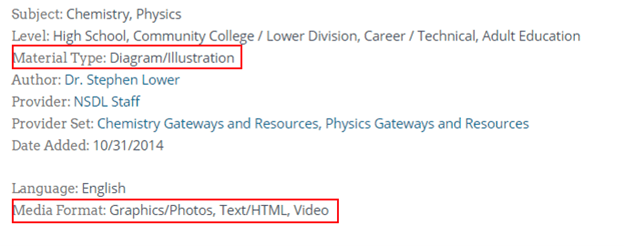Situation Definition:
A situation that arises from difficulty determining the file format of an item in a DL.
Factor(s) Leading to the Situation:
-
- Inappropriate labeling: file formats (text with tooltip) Existing label of a file format does not correctly indicate the format of an item.
- Lack of features/functions/items/information: descriptive information (text with tooltip) Existing item or features does not include a meaningful label, supplementary instruction, or metadata description.
- Unclear Instruction: file type/format (text with tooltip) No indication of the file type/format of an item and/or how to view it
Guideline or Design Recommendation:
-
- Ensure the file format of each item in a DL is clearly and correctly specified and provided to users
- Provide instruction on how to use each file format
Rationale and Objective:
The format of an item (text with tooltip) An information object such as an article, video, or image within a digital collection (e.g. photo, manuscript, audio, and video) is a primary access point for a BVI (text with tooltip) The acronym for Blind and Visually Impaired, and it refers to BVI users who rely on screen readers to understand DL content. user and needs to be immediately recognized by screen readers (text with tooltip) A software program that reads textual information through synthesized speech, and it offers specialized keyboard commands to operate a computer interface (1). Issues arise when users are unable to determine what type of resource they are attempting to access in a DL. For example, “Text” as a simple metadata (text with tooltip) Commonly called ‘data about data,’ it includes structured data to describe and organize resources in the digital environment and enables users to discover and use the content of digital libraries. descriptor is ambiguous in that it could refer to a link to alternative text (text with tooltip) A word or phrase (typically less than 100 characters long) used in the Alt Attribute of an image item or graphical interface element that describes its content or function in the context , or it could refer to the format of an item. For BVI users, therefore, there needs to be a clear description for item format to clarify that “Text” refers to the type of document (e.g., scanned image for a manuscript) and not a supplementary transcript (text with tooltip) A text script that is derived from audio tracks or scanned documents ; such a distinction would eliminate potential confusion or semantic ambiguity.
Techniques and Methods:
1.1. Define the metadata resource type of a DL item using
DCMI
(text with tooltip)
The Dublin Core Metadata Initiative. It is a set of fifteen core elements for describing resources for metadata design across the metadata ecology.
type vocabulary designations (e.g., text, sound, and image)
1.2. Define the file format of a DL item using standardized Internet Media Type vocabulary, formerly known as
MIME
(text with tooltip)
Multipurpose Internet Mail Extension is an internet standard of the format of files for transmitting with standard protocols such as Simple Mail Transfer Protocol (SMTP).
(e.g., pdf, mp4, and jpeg)
1.3. Specify the file format of a DL item through its label
2.1. Provide general help on frequently used file formats to assist users in recognizing resource types
2.2. Provide general help related to software or application tools needed to access different file formats
2.3. Provide
context-sensitive help
(text with tooltip)
A help function that delivers immediate assistance to the user without the user having to leave the current context they are working in
(Help Tips and/or instructions) on how to access the item being investigated
Recommended Features:
1.1. Metadata resource type (See examples 1.1.a/1.2.a, 1.1.b/1.2.b/1.3, and 1.1.c/1.2.c)
1.2. Metadata file format (See examples 1.1.a/1.2.a, 1.1.b/1.2.b/1.3, and 1.1.c/1.2.c)
1.3. Label with file format (See examples 1.1.a/1.2.a, 1.1.b/1.2.b/1.3, and 1.1.c/1.2.c)
2.1/2.2. General Help (See example 2.1/2.2)
2.3. Help tips and/or instruction (See example 2.3)
Examples:
1.1.a/1.2.a. Metadata resource type and file format: How-to example
- Specific metadata description of item types (DCMI type):
-
- Collection: the resource is described as a group; its parts may be separately described and navigated
- Dataset: structured information encoded in lists, tables, databases, etc., which will normally be in a format available for direct machine processing
- Image: the content is primarily symbolic visual representation other than text
- Text: a resource whose content is primarily words for reading
- Specific metadata description of item formats (MIME):
-
- (scanned) image for hand-written manuscripts (jpg)
- transcript for an audio interview file (txt)
- image of newspaper (tiff)
- transcript for newspaper article photo (pdf)
1.1.b/1.2.b/1.3 Metadata resource type and file format: Good design
-
- Indicate resource type (Type [ DCMI (text with tooltip) The Dublin Core Metadata Initiative. It is a set of fifteen core elements for describing resources for metadata design across the metadata ecology. ]) and file format (Digital Format) correctly followed by DCMI
- Indicate specific file format as a label
1.1.c/1.2.c. Metadata resource type and file format: Bad design
Resource type and file format are provided but those do not follow DCMI metadata terms.
2.1/2.2. General Help: Good design
HathiTrust provides file format information and what programs/software are needed to open the file format on the Help page.
2.3. Help tips and/or instruction: How-to example
Add tips into a file format
Related Resources:
-
- Xie, I., Babu, R., Joo, S., & Fuller, P. (2015). Using digital libraries non-visually: Understanding the help-seeking situations of blind users. Information Research: An International Electronic Journal, 20(2), paper 673. Retrieved from http://InformationR.net/ir/20-2/paper673.html.
- IANA.org. (2020). Internet Media Type. Retrieved from https://www.iana.org/assignments/media-types/media-types.xhtml
- Library of Congress. Recommended Formant Statement. Retrieved from https://www.loc.gov/preservation/resources/rfs/index.html
- W3C. (2018). WCAG 2.1 Guideline 1.1 Text Alternatives. Retrieved from https://www.w3.org/TR/WCAG21/#text-alternatives
- W3C. (2018). WCAG 2.1 Guideline 1.2 Time-based Media. Retrieved from https://www.w3.org/TR/WCAG21/#time-based-media
- W3C. (2018). WCAG 2.1 Guideline 1.3 Adaptable. Retrieved from https://www.w3.org/TR/WCAG21/#adaptable
- W3C. (2018). WCAG 2.1 Guideline 3.1 Readable. Retrieved from https://www.w3.org/TR/WCAG21/# readable
See Also:
Help-seeking Situations > B. Difficulty evaluating information



